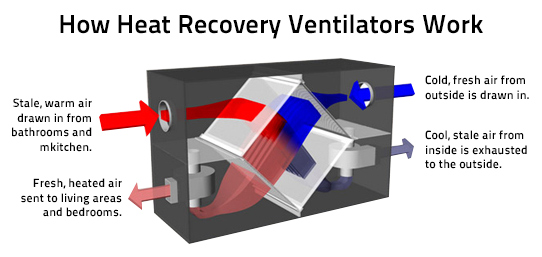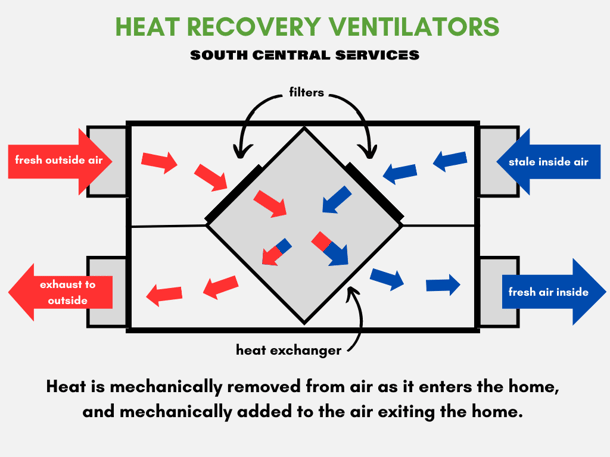Common Questions About HRV Clarified
Wiki Article
Discovering the Conveniences of Heat Recovery Ventilation for Energy Effectiveness in Houses
Heat Recovery Ventilation (HRV) systems use property owners a sensible technique to enhancing energy performance. By redeeming warm from outward bound air, these systems can considerably reduce cooling and heating costs. Additionally, they offer a constant supply of fresh air, improving indoor air quality and comfort levels. As homeowners think about sustainable options, comprehending the nuances of HRV systems becomes increasingly important. What factors should one evaluate before making such an investment?Understanding Heat Recovery Ventilation Systems

Just How HRV Boosts Indoor Air Quality

Energy Savings: The Monetary Benefits of HRV
Making best use of energy efficiency, heat recovery ventilation (HRV) systems use significant economic benefits for homeowners. By recouping and recycling heat from exhaust air, HRVs significantly minimize cooling and heating costs. This innovation can bring about energy cost savings of approximately 30%, relying on environment and use patterns. Home owners usually observe decreased utility costs soon after setup, making HRVs a financially sensible financial investment in time. Furthermore, numerous regions provide incentives or refunds for energy-efficient upgrades, even more improving the economic allure. As power costs continue to climb, the cost-effectiveness of HRVs comes to be significantly clear. Generally, the consolidation of HRV systems not only promotes power effectiveness but additionally adds to long-term economic savings for households.The Environmental Impact of Heat Recovery Ventilation
A significant ecological benefit of heat recovery ventilation (HRV) systems depends on their capability to lower overall energy usage. By redeeming warmth from exhaust air and transferring it to incoming fresh air, HRV systems lessen the demand for energy-intensive heating and cooling techniques. This reduction in power demand adds to decrease greenhouse gas discharges, as less nonrenewable fuel source is needed to maintain comfy HRV Heat Recovery Ventilation indoor temperature levels. Furthermore, HRV systems enhance indoor air top quality by efficiently trading stagnant air with fresh outside air, lowering reliance on mechanical cooling systems that can damage the environment. Overall, the execution of HRV systems supports lasting living techniques and straightens with worldwide initiatives to deal with environment modification by advertising power efficiency in household setups.
Choosing the Right HRV System for Your Home
Just how can home owners ensure they choose the right heat recovery ventilation (HRV) system for their requirements? Initially, they need to evaluate their home's dimension and layout, as these factors influence airflow demands. Next off, reviewing the system's performance ratings is crucial, as greater ratings suggest far better efficiency and power financial savings. Property owners should additionally think about setup and upkeep costs, comparing different brands and designs for value. Additionally, it's crucial to evaluate sound levels, as some systems run more silently than others. Consulting with cooling and heating specialists can give customized recommendations based on specific home problems. Taking a look at user evaluations and service warranties can help in making an educated decision, making sure that the picked HRV system properly boosts interior air high quality and power performance.Frequently Asked Concerns

Exactly how Commonly Should I Clean or Preserve My HRV System?
The regularity of cleansing or keeping a warm recovery ventilation (HRV) system generally depends upon use and ecological variables. Usually, it is recommended to carry out maintenance every six months to assure peak performance and air top quality.
Can HRV Equipments Help In Reducing Moisture Levels Inside Your Home?
HRV systems can effectively reduce indoor humidity levels by exchanging stagnant, moist air with fresh, drier air from outside. HRV Heat Recovery Ventilation. This procedure assists keep a balanced interior atmosphere, boosting convenience and stopping moisture-related concerns
What Is the Lifespan of a Regular HRV System?
The life expectancy of a common heat recovery ventilation (HRV) system differs, normally lasting between 10 to 15 years. Regular upkeep can prolong its effectiveness and functional life, ensuring peak efficiency throughout its usage duration.Exist Any Sound Issues With HRV Systems?
Sound problems with HRV systems can arise, particularly from follower procedure. Several contemporary devices are created to lessen sound levels, ensuring they run silently while maintaining effectiveness, which resolves prospective disruptions in living settings.Can I Set Up an HRV System Myself, or Do I Need an Expert?
The individual contemplated whether to set up the heat recovery ventilation (HRV) system personally or employ a specialist. Typically, while do it yourself installation is feasible, know-how assurances correct performance and conformity with local structure codes, improving system performance.Report this wiki page